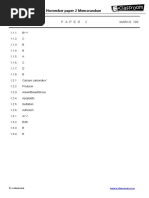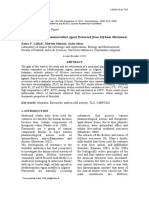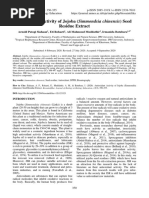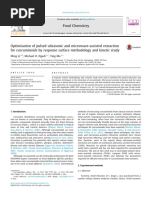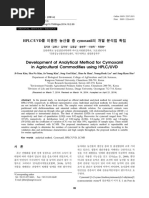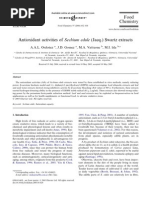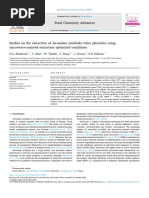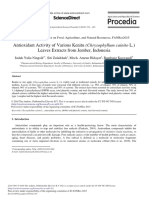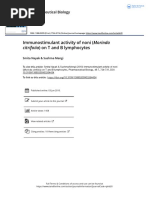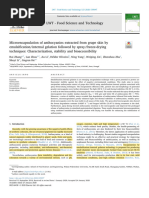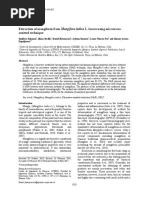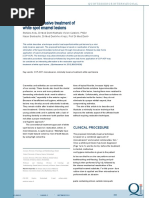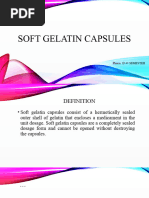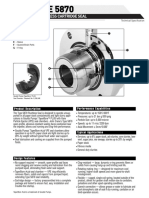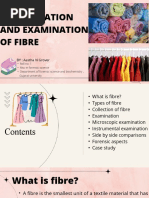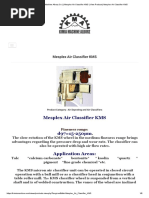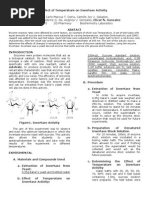Önemli Mikrodalga Stabilite
Önemli Mikrodalga Stabilite
Uploaded by
Safa KaramanCopyright:
Available Formats
Önemli Mikrodalga Stabilite
Önemli Mikrodalga Stabilite
Uploaded by
Safa KaramanOriginal Title
Copyright
Available Formats
Share this document
Did you find this document useful?
Is this content inappropriate?
Copyright:
Available Formats
Önemli Mikrodalga Stabilite
Önemli Mikrodalga Stabilite
Uploaded by
Safa KaramanCopyright:
Available Formats
a
ISSN 0101-2061 Food Science and Technology
DDOI: http://dx.doi.org/10.1590/1678-457X.6731
Microwave-assisted extraction of anthocyanin from Chinese bayberry
and its effects on anthocyanin stability
Wenkai DUAN1,2, Shiping JIN2, Guofu ZHAO2, Peilong SUN1*
Abstract
Anthocyanins are present in high concentrations in Chinese bayberry, Myrica rubra Sieb. & Zucc. Herein, a microwave-assisted
extraction was used to extract the anthocyanins from Chinese bayberry. The HPLC chromatogram of the extracts showed that
the anthocyanin components were slightly hydrolysed during the extraction process. Further experiments confirmed that
microwave irradiation slightly hydrolysed cyanidin-3-O-glucoside to cyanidin, but did not significantly influence the antioxidant
activity of the extracts. Optimized extraction conditions for total anthocyanin content were a solid-to-liquid ratio, extraction
temperature, and extraction time of 1:50, 80 °C, and 15 min, respectively. Under these conditions, the anthocyanin content
was 2.95 ± 0.08 mg·g−1, and the antioxidant activity yield was 279.96 ± 0.1 μmol.·g−1 Trolox equivalent on a dry weight basis.
These results indicated that microwave-assisted extraction was a highly efficient extraction method with reduced processing
time. However, under some extraction conditions it could damage the anthocyanins. These results provide an important guide
for the application of microwave extraction.
Keywords: Chinese bayberry; anthocyanin extraction; microwave-assisted extraction; cyanidin-3-O-glucoside; anthocyanin
stability.
Practical Application: This study showed that microwave irradiation would slightly hydrolysed cyanidin-3-O-glucoside to
cyanidin, it provide an important guide for the application of microwave extraction.
1 Introduction
Chinese bayberry, Myrica rubra Sieb. & Zucc., is one of the supercritical fluid, pressurized fluid, and microwave-assisted
six Myrica species native to China (Chen et al., 2004), and is noted extraction (Schantz et al., 1997; Lopez‑Avila et al., 1994).
for the attractive red colour of its fruits. Many pigments were
Microwave-assisted extraction (MAE) has been demonstrated
extracted, identified, and characterized from different natural to be a fast and efficient unconventional extraction method
sources, especially red fruit extracts, for their safe use as colorants. that was developed for extracting analytes from solid matrixes,
Anthocyanins are among the most broadly distributed pigment in particular, secondary metabolites from plant material
groups in plants, and are present at high concentration in Chinese (Kaufmann & Christen, 2002), such as saponins from ginseng
bayberry. The major anthocyanin present in bayberry fruits was (Kwon et al., 2003; Vongsangnak et al., 2004), glycyrrhizic
identified as cyanidin-3-O-glucoside (C-3-G), which represents acid from licorice root (Pan et al., 2000), anthocyanins in red
more than 95% of the total pigment content (Bao et al., 2005). raspberries (Sun et al., 2007), and alkaloids from the seeds of
Anthocyanins from Chinese bayberry can protect β-cells Lupinus mutabilis (Ganzler et al., 1990). Microwave energy is a
from oxidative-stress mediated injury (Zhang et al., 2011) and non-ionizing radiation that results in molecular movement by
contribute to promoting good health and reducing the risk of migration of ions and rotation of molecules with permanent
chronic disease (Philpott et al., 2004). dipoles in liquids, without altering their molecular structures
Extraction is the first step in the commercial isolation of unless the temperature is too high (Kaufmann & Christen, 2002).
anthocyanins. Conventional extraction techniques for solid Microwave extraction greatly reduces solvent consumption and
matrices include the well-known Soxhlet extraction, sonication, extraction times and improves extraction efficiency (Eskilsson
and blending. Although efficient extractions can be achieved & Björklund, 2000).
using these simple techniques, they present major drawbacks. The stability of anthocyanin is very important during the
In particular, they feature long extraction times (especially for extraction, and is influenced by numerous factors, including
Soxhlet extraction), high solvent consumption, and low temperatures, temperature, pH, water activity, and light (Amr & Tamini, 2007).
and they are not yet readily automated (Heemken et al., 1997; Recently, a study suggested that vitamin C was unstable under
Egizabal et al., 1998). Over the last decade, new techniques have microwave conditions (Yuan et al., 2009), whereas some
emerged that will supersede traditional techniques. These include confirmed that microwaving preserved bioflavonoid content
Received 18 May, 2015
Accepted 03 August, 2015
1
Laboratory of Food Energy, Zhejiang University of Technology, Hangzhou, PR, China
2
Taizhou Vocational College of Science & Technology, Taizhou, PR, China
*Corresponding author: sun_peilong@163.com
524 Food Sci. Technol, Campinas, 35(3): 524-530, Jul.-Set. 2015
Duan et al.
(Gorinstein et al., 2008; El-Adawy, 2002). Thus, the effect of and absorbance of A = [(A520 − A700)pH 1.0 − (A520 − A700)pH 4.5].
microwave irradiation on the stability of anthocyanin needs to The data were reported as mean ± standard deviation for three
be further studied. replications.
Herein, MAE was used to extract antioxidant compounds
from Chinese bayberry. The aim of this work was to elucidate 2.5 HPLC-DAD-ESI-MS analysis
the optimal extraction conditions and evaluate whether it affects HPLC-DAD-ESI-MS analysis was performed using a Waters
the structure or antioxidant activity of the extracted compounds. platform system, which was composed of a Micromass QUATTRO
MICROTM API mass spectrometer, a Waters 600 pump system,
2 Materials and methods and a Waters 2996 photodiode array detector (Waters Corp.,
2.1 Chemicals and reagents Milford, MA, USA). Data were collected and processed on a
personal computer running MassLynx software (Micromass, a
Cyanidin-3-O-glucoside standard was obtained from division of Waters Corp., Beverly, MA, USA). Aliquots of bayberry
Extrasynthèse (Genay, France). 6-Hydroxy-2,5,7,8-tetramethyl- extracts (20 μL) were resolved using a SUNFIRE C-18 column
chroman-2- carboxylic acid (Trolox) and 2,2-Diphenyl-1- (250×4.6 mm, 5μm, Waters Corp., Milford, MA, USA), where
picrylhydrazyl (DPPH) were purchased from Sigma Chemical solvent A was 0.05% (v/v) formic acid in water, and solvent B
Co. (St. Louis, MO, USA). Acetonitrile (HPLC grade), formic was 0.05% (v/v) formic acid in acetonitrile, and the flow rate
acid, ethanol, and hydrochloric acid (analytical grade) were was 0.7 mL·min−1. The injection volume was 20 μL, and the
purchased from Shanghai Chemical Reagent Company (China). detection wavelengths was 520 nm. The elution system was:
All solutions were prepared using distilled-deionized water. 0–5 min = 5% solvent B, 5–10 min = linear gradient from 5–10%
of solvent B, 10–25 min = linear gradient from 10–90% of solvent
2.2 Plant material B, and 25–50 min = 90% solvent B. Cyanidin-3-O-glucoside was
Myrica rubra Sieb. & Zucc. cv. Dongkui belongs to the genus used as a standard for quantitation of cyanidin-3-O-glucoside
Myrica in the family Myricaceae. Mature Chinese bayberry content, the ratio of cyanidin-3-O-glucoside to total anthocyanin
fruits were obtained from a fruit market in Taizhou, Zhejiang was expressed to total anthocyanin content divided by the content
Province, China in June 2013. The samples were immediately of cyanidin-3-O-glucoside.
dried in a lyophilizer (Labconco, Kansas City, USA), and then Mass spectra were obtained using electrospray ionization in
ground and sifted for homogenization before storing at −80 °C positive ion mode. The following ion optics were used: capillary
to avoid the degradation of the compounds. = 3.88 kV and cone = 60 V. The source block temperature was
90 °C and the desolvation temperature was 150 °C. Continuous
2.3 Microwave-assisted extraction mass spectra were recorded over m/z 50–800 with a scan time
of 1 min and interscan delay of 0.15 s.
The microwave-assisted extraction was performed using
a microwave accelerated reaction system (MARSXpress, CEM
2.6 Evaluation of antioxidant activity using the DPPH
Cooperation, Matthews, NC, USA) with a microwave power of
method
800 W, equipped with a digital timer and temperature controller.
The scavenging effects of the samples on the 2,2-diphenyl-1-
The dried bayberry powder (0.50 g) was accurately weighed,
picrylhydrazyl (DPPH) radical were monitored using the previously
placed in a tube, and mixed with an appropriate amount of
reported method (Bao et al., 2005; Zhou et al., 2009). In summary,
extracting solvent (1% HCl in 95%ethanol). After thorough
0.1 mL of the diluted sample was added to 3.9 mL of 0.1 mmol·L−1
mixing, the tube containing the suspension was irradiated,
DPPH solution. It was vortexed and then allowed to react at
using a predetermined extraction time and temperature, in the
ambient temperature for 30 min in the dark. The absorbance at
microwave device. After the microwave extraction, the sample
517 nm was measured using a spectrophotometer. A calibration
was centrifuged at 8000 rpm for 10 min, and then the supernatant
curve was constructed for the decrease in absorbance based on
was collected and all samples were diluted to the same volume.
trolox concentration, and 0.1 mL of 95% ethanol was used as a
All of the samples were filtered through a 0.45-μm syringe filter
control. The inhibition ratio was calculated as follows:
(Pall Life Sciences, Ann Arbor, MI, USA).
Inhibition ratio (%) = 100×(Ao−As)/Ao, where Ao and As
2.4 Determination of anthocyanin content represent the absorbance of the control and sample solutions,
respectively. The antioxidant activity was expressed as μmol
The total anthocyanin content of extracts was determined Trolox equivalent g−1 dry weight.
using a modified pH differential method described previously
(Kim et al., 2003; Zhou et al., 2009). A general spectrophotometer
2.7 Experimental design and statistical analysis
(T6 New Century, Purkinje General Instrument Co., Beijing, China)
was used to measure absorbance at 520 and 700 nm in buffers at pH A three-level three-factor Box–Behnken design was
1.0 and 4.5. The absorbance measurements were converted into total selected to evaluate the combined effect of three independent
milligrams of cyanidin-3-glucoside per gram dry weight of bayberry variables: solid to liquid ratio, extraction temperature, and
using the molar extinction coefficient, ε = 26 900 L·mol−1·cm−1, time, which were coded as X1, X2, and X3, respectively (Table 1).
Food Sci. Technol, Campinas, 35(3): 524-530, Jul.-Set. 2015 525
Microwave extract anthocyanin and antioxidant
In total, 15 experiments with three replicates at the centre were 3 Results and discussion
employed. The response surface methodology (RSM) was used 3.1 HPLC analysis of anthocyanins extracted from chinese
to determine the optimum conditions for the extraction of bayberry
anthocyanins from Chinese bayberry. The experimental design
Anthocyanins were extracted from Chinese bayberry using
and statistical analysis were performed using Stat-Ease software
a microwave-assisted method. The HPLC chromatogram of the
(Design-Expert 7.0.10 Trial, Delaware, USA). The generalized anthocyanins is shown in Figure 1. Peak 1 displayed at m/z 287,
second order polynomial model used for the response surface corresponding to the molecular of cyanidin, was assumed to be
analysis was as follows: cyanidin according to the reported by Zhao et al. (2013). Peak 2 has
an m/z 449 corresponding to [M]+, with a characteristic fragmentation
3 3 2
b0 + ∑ bi X i + bii ∑ X i2 + ∑
3
[M-162]+ at 287 corresponding to the cleavage of glucose, hence, it
Y= ∑ bim X i X m (1)
was assigned as cyanidin-3-O-glucoside. By comparing its HPLC
i= 1 i= 1 i = 1 m = i +1
retention time to a cyanidin-3-O-glucoside standard, peak 2 was
where the response function, Y, was partitioned into linear, further confirmed as cyanidin-3-O-glucoside. We suggest that
quadratic, and interactive components, b0, bi, bii, and bim are cyanidin might be the hydrolysis product of cyanidin-3-O-glucose
defined as the constant, linear coefficient, quadratic coefficient, formed during the microwave-assisted extraction. Although it
has been reported that malvidin-3-glucoside and malvidin-3,5-
and cross-product coefficient, respectively, and Xi and Xm are
diglucoside might hydrolyze to the products of anthocyanone,
the levels of the independent variables. Analysis of variance hydroxycoumarins and dihydroxy phenylacetaldehyde under
(ANOVA) tables were generated, and the effect and regression microwave treatment (Ramirez et al., 2015), this finding imply
coefficients of the individual linear, quadratic, and interaction that there may be other anthocyanin degradation pathway
terms were determined. under different conditions, such as cyanidin, delphinidin and
Table 1. Code and actual levels of three variables.
Code levels
Independent variables Units Symbol
–1 0 1
Solid to liquid ratio 1:X X1 30 40 50
T [°C] X2 40 60 80
t [min] X3 5 10 15
Figure 1. HPLC profile of the anthocyanin extracted from Chinese bayberry using a microwave-assisted method. 1 = Cyanidin; 2 = Cyanidin-3-O-glucoside
(C-3-G). UV-Vis detection at 520 nm. (a) under 80 °C extract condition; (b) under 60 °C extract condition.
526 Food Sci. Technol, Campinas, 35(3): 524-530, Jul.-Set. 2015
Duan et al.
pelargonidin can be extracted from fresh floral and vegetative yield of anthocyanins extracted from Chinese bayberry using a
tissue by using 2M HCl leaching (Des Marais & Rausher, 2010). microwave-assisted method. The C-3-G and total anthocyanin
contents in the microwave-assisted extract were determined,
3.2 Effects of microwave irradiation on and the ratio of C-3-G to total anthocyanin was calculated.
Cyanidin-3-O-glucose hydrolysis The antioxidant activity of the microwave-assisted extracts was
also determined. These results are listed in Table 3.
Cyanidin is an anthocyanin and is bound to glucose to form
C-3-G, which is the main component of anthocyanins in the A positive correlation between the total anthocyanins and
fruit of Chinese bayberry (Tanaka et al., 2008). Although it is the antioxidant activity (R2 = 0.8431, Figure 2) was observed,
well documented that there is no significant difference between which agrees with previous findings (Kähkönen & Heinonen,
the antioxidant activity of cyanidin and C-3-G (Kähkönen & 2003). Because C-3-G is hydrolysed into cyanidin in human
Heinonen, 2003), we used a C-3-G standard to evaluate the effect bodies (Min et al., 2010), it is better to optimize the extraction
of microwaves on the hydrolysis and release of cyanidin and its
antioxidant activity. A two-factor and two-level experimental
design was conducted to evaluate the influence of temperature
and extraction time on the hydrolysis of C-3-G. The results
are shown in Table 2. Two-way ANOVA results showed that
increasing the temperature increased the total anthocyanin
content, but decreased the ratio of C-3-G to total anthocyanin,
whereas it had no significant effect on the antioxidant activity
of the extracts. Increasing the extraction time did not increase
the antioxidant activity of the extracts or the total anthocyanin
content, but significantly decreased the ratio of C-3-G to total
anthocyanin, especially when extracting at 80 °C.
3.3 Optimization of the microwave-assisted extraction
conditions
A three-level three-factor Box–Behnken design was selected
to evaluate the combined effect of three independent variables: Figure 2. The correlation between total anthocyanin content and
solid to liquid ratio, extraction temperature, and time on the antioxidant activity (R2 = 0.8431).
Table 2. Effect of microwave irradiation on the hydrolysis of C-3-G.
40 °C 80 °C
5 min 15 min 5 min 15 min
DPPH [%] 60.73 ± 1.36 63.43 ± 3.20 64.17 ± 2.21 64.60 ± 0.96
Total anthocyanin [mg·L–1] 26.33 ± 1.15 26.67 ± 1.15 28.67 ± 0.58 29.67 ± 1.15
C-3-G/total anthocyanin [%] 98.00 ± 0.61 97.00 ± 0.56 76.00 ± 0.92 48.00 ± 1.15
Table 3. Response surface design and experimental dataa.
Total anthocyanin yield Total antioxidant
Run X1 X2 X3 C-3-G yield [mg·g–1] C-3-G/total anthocyanin
[mg·g–1] activityb [μmol·g–1]
1 1 0 1 1.97 2.85 0.69 271.07
2 0 1 –1 1.83 2.51 0.73 230.56
3 1 –1 0 0.73 1.10 0.66 120.78
4 1 0 –1 1.30 1.86 0.70 161.26
5 –1 0 1 1.70 2.20 0.77 226.38
6 0 –1 –1 1.38 1.87 0.74 162.8
7 0 –1 1 1.39 2.07 0.67 153.56
8 –1 0 –1 1.60 2.29 0.70 173.14
9 –1 1 0 1.77 2.37 0.75 240.24
10 0 1 1 1.89 2.69 0.70 261.8
11 –1 –1 0 0.90 1.41 0.64 119.68
12 1 1 0 1.93 2.57 0.75 250.80
13 0 0 0 1.43 1.97 0.73 185.24
14 0 0 0 1.48 2.02 0.73 195.58
15 0 0 0 1.37 1.96 0.70 194.92
a
Yields and activities are based on dry weight. X1, X2 and X3 are defined in Table 1. bAntioxidant activity was expressed as μmol of Trolox equivalent per g of dry weight.
Food Sci. Technol, Campinas, 35(3): 524-530, Jul.-Set. 2015 527
Microwave extract anthocyanin and antioxidant
to target the total anthocyanin content if we are only concerned
with their health benefits. However, the extraction conditions
should be optimized to target the C-3-G content if purified
C-3-G from Chinese bayberry is required.
The total anthocyanin content was optimized using an RSM
analysis. The polynomial equation of the quadratic model was
as follows:
Y=1.98+0.014X1+0.46X2+0.16X3+0.13X1X2+0.27X1X3−2.5
×10-3X2X3−0.054X12 −0.067X22+0.37X32 (Fmodel =7.32; p < 0.05;
R2 =0.9295), where Y, X1, X2, and X3 are the total anthocyanin
yield, solid to liquid ratio, extraction temperature, and extraction
time, respectively.
The maximum total anthocyanin yield of 2.95 mg·g–1 on a
dry weight basis was obtained when using the optimal extraction
conditions: solid to liquid ratio, extraction temperature, and time
of 1:50, 80 °C, and 15 min, respectively. The ANOVA statistics
showed that the experimental data had correlation coefficient
R2 = 0.9295 with the calculated model.
To confirm these results, Chinese bayberry powder was
extracted in triplicate using the above-mentioned conditions.
The anthocyanin yield was 2.95 ± 0.08 mg·g−1 with an antioxidant
activity yield of 279.96 ± 0.1 μmol·g−1 equivalent of Trolox on
a dry weight basis.
The C-3-G content was also optimized using an RSM analysis.
The polynomial equation of the quadratic model was as follows:
Figure 3. The response surfaces for the effects of temperature
Y=1.43+0.005X1+0.43X2+0.16X3+0.083X1X2+0.14X1X3+0.11X2X3 and solid to liquid ratio on the yield of total anthocyanin (a) and
−0.088X12 −0.006X22+0.30X32 (Fmodel =15.47; p < 0.05; R2 =0.965), cyanidin-3-O-glucoside (b).
where Y, X1, X2, and X3 are the yield of C-3-G, solid to liquid
ratio, extraction temperature, and extraction time, respectively.
a high solid to liquid ratio because low extract concentrations
The maximum C-3-G yield of 2.01 mg·g-1 on a dry weight would reduce the solubility.
basis was obtained when using the optimal extraction conditions:
solid to liquid ratio, extraction temperature, and time of 1:50,
4 Conclusion
75.8 °C, and 14.7 min, respectively. The ANOVA statistics
showed that the experimental data had correlation coefficient We first investigated the effect of microwave irradiation
R2 = 0.956 with the calculated model. on the extracted components. HPLC-DAD-ESI-MS analysis
of the extract implied that cyanidin-3-O-glucoside have been
The total anthocyanin and C-3-G contents extracted were hydrolysed to cyanidin during the extraction process. To confirm
affected by the three variables studied, but they were most whether microwave irradiation damaged the anthocyanins,
greatly influenced by the extraction temperature. Increased a cyanidin-3-O-glucoside standard was used to evaluate the
temperature significantly increased the extraction of total effects of microwave irradiation on the hydrolysis and release
anthocyanins and C-3-G (Figure 3), and was able to modify of cyanidin and its antioxidant activity. Our results showed that
the equilibrium and mass transfer conditions of the solid-liquid cyanidin-3-O-glucoside hydrolysed to cyanidin, but the antioxidant
extraction. Although higher temperatures had a positive effect activity was not significantly changed during the extraction
on the extraction yields, the temperature cannot be increased process featuring high temperature and long extraction times.
indefinitely because of the thermal instability of anthocyanin
compounds (Liazid et al., 2011). Finally, we used the RSM method to optimize the extraction
conditions and a positive correlation was found between the
The solid to liquid ratio also had an effect on the extraction total anthocyanin content and antioxidant activity, R2=0.8431.
of total anthocyanins and C-3-G. An increase in the solid to The maximum total anthocyanin yield of 2.95 mg·g−1, and an
liquid ratio resulted in increased total anthocyanin and C-3-G antioxidant activity yield of 279.96 ± 0.1 μmol·g−1 equivalent of
extraction (Figure 3). At high extract concentrations, the Trolox on a dry weight basis were obtained under the optimal
solubility would have increased, and then an increase in the conditions where the solid to liquid ratio, extraction temperature,
solid to liquid ratio resulted in a greater extraction of the total and extraction time were 1:50, 80 °C, and 15 min, respectively,
anthocyanin and C-3-G; however, values increased slowly at whereas the maximum cyanidin-3-O-glucoside yield of 2.01 mg·g−1
528 Food Sci. Technol, Campinas, 35(3): 524-530, Jul.-Set. 2015
Duan et al.
on a dry weight basis was obtained under conditions there the Kaufmann, B., & Christen, P. (2002). Recent extraction techniques for
solid to liquid ratio, extraction temperature, and extraction time natural products: microwave-assisted extraction and pressurised
were 1:50, 75.8 °C, and 14.7 min, respectively. solvent extraction. Phytochemical Analysis: PCA, 13(2), 105-113.
http://dx.doi.org/10.1002/pca.631. PMid:12018022.
These results provide an important guide for the application of
Kim, D., Jeong, S. W., & Lee, C. Y. (2003). Antioxidant capacity of phenolic
microwave extraction when extracting anthocyanins from plants. phytochemicals from various cultivars of plums. Food Chemistry,
81(3), 321-326. http://dx.doi.org/10.1016/S0308-8146(02)00423-5.
Acknowledgements Kwon, J. H., Bélanger, J. M., & Paré, J. R. (2003). Optimization of
We thank Fangyong Chen for providing the Chinese microwave-assisted extraction (MAP) for ginseng components by
bayberry materials. response surface methodology. Journal of Agricultural and Food
Chemistry, 51(7), 1807-1810. http://dx.doi.org/10.1021/jf026068a.
PMid:12643634.
References Liazid, A., Guerrero, R. F., Cantos, E., Palma, M., & Barroso, C. G.
Amr, A., & Tamini, E. A. (2007). Stability of the crude extracts of (2011). Microwave assisted extraction of anthocyanins from grape
Ranunculus asiaticus anthocyanins and their use as food colorants. skins. Food Chemistry, 124(3), 1238-1243. http://dx.doi.org/10.1016/j.
International Journal of Food Science and Technology, 42, 985-991. foodchem.2010.07.053.
Bao, J., Cai, Y., Sun, M., Wang, G., & Corke, H. (2005). Anthocyanins, Lopez-Avila, V., Young, R., & Beckert, W. F. (1994). Microwave-assisted
flavonols, and free radical scavenging activity of Chinese bayberry extraction of organic compounds from standard reference soils and
(Myrica rubra) extracts and their color properties and stability. sediments. Analytical Chemistry, 66(7), 1097-1106. http://dx.doi.
Journal of Agricultural and Food Chemistry, 53(6), 2327-2332. http:// org/10.1021/ac00079a027.
dx.doi.org/10.1021/jf048312z. PMid:15769176. Min, S. W., Ryu, S. N., & Kim, D. H. (2010). Anti-inflammatory effects of
Chen, K., Xu, C., Zhang, B., & Ferguson, I. B. (2004). Red bayberry: black rice, cyanidin-3-O-β-D-glycoside, and its metabolites, cyanidin
botany and horticulture. Horticultural Reviews, 30, 83-114. and protocatechuic acid. International Immunopharmacology, 10,
Des Marais, D. L., & Rausher, M. D. (2010). Parallel evolution at multiple 959-966.
levels in the origin of hummingbird pollinated flowers in Ipomoea. Pan, X., Liu, H., Jia, G., & Shu, Y. Y. (2000). Microwave-assisted extraction
Evolution, 64(7), 2044-2054. PMid:20148948. of glycyrrhizic acid from licorice root. Biochemical Engineering Journal,
Egizabal, A., Zuloaga, O., Etxebarria, N., Fernandez, L. A., & Madariaga, 5(3), 173-177. http://dx.doi.org/10.1016/S1369-703X(00)00057-7.
J. M. (1998). Comparison of microwave-assisted extraction and PMid:10828417.
Soxhlet extraction for phenols in soil samples using experimental Philpott, M., Gould, K. S., Lim, C., & Ferguson, L. R. (2004). In situ and
designs. Analyst (London), 123(8), 1679-1684. http://dx.doi. in vitro antioxidant activity of sweetpotato anthocyanins. Journal of
org/10.1039/a802117a. Agricultural and Food Chemistry, 52(6), 1511-1513. http://dx.doi.
El-Adawy, T. A. (2002). Nutritional composition and antinutritional org/10.1021/jf034593j. PMid:15030203.
factors of chickpeas (Cicer arietinum L.) undergoing different cooking Ramirez, J. E., Zambrano, R., Sepúlveda, B., Kennelly, E. J., & Simirgiotis,
methods and germination. Plant Foods for Human Nutrition, 57(1), M. J. (2015). Anthocyanins and antioxidant capacities of six Chilean
83-97. http://dx.doi.org/10.1023/A:1013189620528. PMid:11855623.
berries by HPLC-HR-ESI-ToF-MS. Food Chemistry, 176, 106-114.
Eskilsson, C. S., & Björklund, E. (2000). Analytical-scale microwave- http://dx.doi.org/10.1016/j.foodchem.2014.12.039. PMid:25624212.
assisted extraction. Journal of Chromatography. A, 902(1), 227-250.
Schantz, M. M., Nichols, J. J., & Wise, S. A. (1997). Evaluation of
http://dx.doi.org/10.1016/S0021-9673(00)00921-3. PMid:11192157.
pressurized fluid extraction for the extraction of environmental
Ganzler, K., Szinai, I., & Salgó, A. (1990). Effective sample preparation matrix reference materials. Analytical Chemistry, 69(20), 4210-4219.
method for extracting biologically active compounds from different http://dx.doi.org/10.1021/ac970299c.
matrices by a microwave technique. Journal of Chromatography. A,
Sun, Y. Z., Liao, X. J., Wang, Z. F., Hu, X. S., & Chen, F. (2007).
520, 257-262. http://dx.doi.org/10.1016/0021-9673(90)85109-9.
PMid:2086582. Optimization of microwave-assisted extraction of anthocyanins in
red raspberries and identification of anthocyanin of extracts using
Gorinstein, S., Leontowicz, H., Leontowicz, M., Namiesnik, J., high-performance liquid chromatography- mass spectrometry.
Najman, K., Drzewiecki, J., Cvikrová, M., Martincová, O., Katrich, European Food Research and Technology, 225(3-4), 511-523. http://
E., & Trakhtenberg, S. (2008). Comparison of the main bioactive
dx.doi.org/10.1007/s00217-006-0447-1.
compounds and antioxidant activities in garlic and white and red
onions after treatment protocols. Journal of Agricultural and Food Tanaka, Y., Sasaki, N., & Ohmiya, A. (2008). Biosynthesis of plant
Chemistry, 56(12), 4418-4426. http://dx.doi.org/10.1021/jf800038h. pigments: anthocyanins, betalains and carotenoids. The Plant
PMid:18494496. Journal : for Cell and Molecular Biology, 54(4), 733-749. http://dx.doi.
org/10.1111/j.1365-313X.2008.03447.x. PMid:18476875.
Heemken, O. P., Theobald, N., & Wenclawiak, B. W. (1997). Comparison
of ASE and SFE with soxhlet, sonication, and methanolic saponification Vongsangnak, W., Gua, J., Chauvatcharin, S., & Zhong, J. J. (2004).
extractions for the determination of organic micropollutants in Towards efficient extraction of notoginseng saponins from cultured
marine particulate matter. Analytical Chemistry, 69(11), 2171-2180. cells of Panax notoginseng. Biochemical Engineering Journal, 18(2),
http://dx.doi.org/10.1021/ac960695f. PMid:21639259. 115-120. http://dx.doi.org/10.1016/S1369-703X(03)00197-9.
Kähkönen, M. P., & Heinonen, M. (2003). Antioxidant activity of Yuan, G. F., Sun, B., Yuan, J., & Wang, Q. M. (2009). Effects of different
anthocyanins and their aglycons. Journal of Agricultural and Food cooking methods on health-promoting compounds of broccoli.
Chemistry, 51(3), 628-633. http://dx.doi.org/10.1021/jf025551i. Journal of Zhejiang University. Science. B., 10(8), 580-588. http://
PMid:12537433. dx.doi.org/10.1631/jzus.B0920051. PMid:19650196.
Food Sci. Technol, Campinas, 35(3): 524-530, Jul.-Set. 2015 529
Microwave extract anthocyanin and antioxidant
Zhang, B., Kang, M., Xie, Q., Xu, B., Sun, C., Chen, K., & Wu, Y. (2011). of malvidin-3-glucoside and malvidin-3,5-diglucoside under
Anthocyanins from Chinese bayberry extract protect β cells from microwave treatment. Food Chemistry, 141(3), 3260-3267. http://
oxidative stress-mediated injury via HO-1 upregulation. Journal dx.doi.org/10.1016/j.foodchem.2013.05.147. PMid:23871085.
of Agricultural and Food Chemistry, 59(2), 537-545. http://dx.doi. Zhou, S. H., Fang, Z. X., Lu, Y., Chen, J. C., Liu, D. H., & Ye, X. Q.
org/10.1021/jf1035405. PMid:21166417. (2009). Phenolics and antioxidant properties of bayberry (Myrica
Zhao, M., Luo, Y., Li, Y., Liu, X., Wu, J., Liao, X., & Chen, F. (2013). The rubra Sieb. et Zucc.) Pomace. Food Chemistry, 112(2), 394-399.
identification of degradation products and degradation pathway http://dx.doi.org/10.1016/j.foodchem.2008.05.104.
530 Food Sci. Technol, Campinas, 35(3): 524-530, Jul.-Set. 2015
You might also like
- Grade 10 - Life Science - November Paper 2-2 - MemoDocument4 pagesGrade 10 - Life Science - November Paper 2-2 - MemoJustinCase199150% (4)
- DGR Manual 2021 PDFDocument114 pagesDGR Manual 2021 PDFreceipt sectionNo ratings yet
- Saint Louis University School of Engineering and Architecture Department of Chemical EngineeringDocument132 pagesSaint Louis University School of Engineering and Architecture Department of Chemical EngineeringPaul Philip LabitoriaNo ratings yet
- Extraction and StabilityDocument8 pagesExtraction and Stabilitydinarapril96No ratings yet
- PptDocument17 pagesPptSanjiv PandaNo ratings yet
- Publish ArticleDocument8 pagesPublish ArticleErika AliefNo ratings yet
- Silymarin Natural Antimicrobiol Agent Extracted From Silybum MarianumDocument6 pagesSilymarin Natural Antimicrobiol Agent Extracted From Silybum MarianumJoha Castillo JaramilloNo ratings yet
- Microwave-Assisted Extraction of Phenolic Compounds From Pineapple Peel Against Staphylococcus Aureus and Escherichia ColilDocument8 pagesMicrowave-Assisted Extraction of Phenolic Compounds From Pineapple Peel Against Staphylococcus Aureus and Escherichia ColilMuhammad JahidingNo ratings yet
- 2252-Article Text-8408-2-10-20201018Document17 pages2252-Article Text-8408-2-10-20201018Samantha Garcia NovoaNo ratings yet
- Food Chemistry: Yongqiang Wang, Yujie Gao, Hui Ding, Shejiang Liu, Xu Han, Jianzhou Gui, Dan LiuDocument7 pagesFood Chemistry: Yongqiang Wang, Yujie Gao, Hui Ding, Shejiang Liu, Xu Han, Jianzhou Gui, Dan LiuDessy Erlyani Mugita SariNo ratings yet
- 1 s2.0 S2772753X22001149 MainDocument7 pages1 s2.0 S2772753X22001149 MainTiendatNguyenNo ratings yet
- Extracting Phenolic Compounds From Hibiscus Sabdariffa L. Calyx UsingDocument10 pagesExtracting Phenolic Compounds From Hibiscus Sabdariffa L. Calyx UsingAngela Flores DiazNo ratings yet
- Antioxidant, Antimicrobial Activity andDocument7 pagesAntioxidant, Antimicrobial Activity andDidi Haryo TistomoNo ratings yet
- Belhadj Slimen Et Al., 2017Document12 pagesBelhadj Slimen Et Al., 2017fakhrouNo ratings yet
- 10Document5 pages10Xuân BaNo ratings yet
- 1 s2.0 S1878535213000397 MainDocument13 pages1 s2.0 S1878535213000397 MainĐại HảiNo ratings yet
- Contoh Naksh Masuk (Jurnal Ike Sitoresmi Optimasi Revisi 2-1)Document14 pagesContoh Naksh Masuk (Jurnal Ike Sitoresmi Optimasi Revisi 2-1)Erika AliefNo ratings yet
- Antioxidant and Cytotoxic Effects of Methanol Extracts of AmorphophallusDocument4 pagesAntioxidant and Cytotoxic Effects of Methanol Extracts of AmorphophallusDidar SadiqNo ratings yet
- 05 Intan Soraya Che Sulaiman - Paling FunctionDocument14 pages05 Intan Soraya Che Sulaiman - Paling FunctionIdham ZaharudieNo ratings yet
- carini2001Document10 pagescarini2001yosraNo ratings yet
- Food and Chemical Toxicology: Amar Djeridane, Mohamed Yousfi, Jean Michel Brunel, Pierre StockerDocument8 pagesFood and Chemical Toxicology: Amar Djeridane, Mohamed Yousfi, Jean Michel Brunel, Pierre StockerRidho Dhe HolmesNo ratings yet
- Innovative Food Science and Emerging Technologies: Zhendong Yang, Weiwei ZhaiDocument7 pagesInnovative Food Science and Emerging Technologies: Zhendong Yang, Weiwei ZhaiToñoSanjuanNo ratings yet
- IJETR021655Document5 pagesIJETR021655erpublicationNo ratings yet
- Jurnal Titik IsmandariDocument11 pagesJurnal Titik Ismandarititik ismandariNo ratings yet
- Antioxidant Activity of Jojoba (Simmondsia Chinensis) Seed Residue ExtractDocument6 pagesAntioxidant Activity of Jojoba (Simmondsia Chinensis) Seed Residue Extract????? ??????No ratings yet
- Inonotus Obliquus Mycelia and Incubated Under Different CultivatingDocument9 pagesInonotus Obliquus Mycelia and Incubated Under Different Cultivatingzalanus13No ratings yet
- Extracts From Pitanga Eugenia Uniflora LDocument9 pagesExtracts From Pitanga Eugenia Uniflora LVennyNo ratings yet
- Mechanisms of Molluscicidal Activity of Citrus Hystrix Against Pomacea CanaliculataDocument8 pagesMechanisms of Molluscicidal Activity of Citrus Hystrix Against Pomacea Canaliculataden mNo ratings yet
- Optimization: Microwave Irradiation Effect On Polyphenolic Compounds Extraction FROM WINTER SAVORY (Satureja Montana L.)Document30 pagesOptimization: Microwave Irradiation Effect On Polyphenolic Compounds Extraction FROM WINTER SAVORY (Satureja Montana L.)Sergio mauricio sergioNo ratings yet
- Effects of Postharvest Application of Methyl Jasmonate On Physicochemical Characteristics and Antioxidant System of The Blueberry FruitDocument8 pagesEffects of Postharvest Application of Methyl Jasmonate On Physicochemical Characteristics and Antioxidant System of The Blueberry FruitFernando Herrero SinNo ratings yet
- Kami Export - Effect of UV-C Treatment On The Quality of Fresh-Cut Lotus (Nelumbo NuciferaDocument6 pagesKami Export - Effect of UV-C Treatment On The Quality of Fresh-Cut Lotus (Nelumbo NuciferaYaisa Quinto VidalNo ratings yet
- Ajmbr 1 1 3 PDFDocument7 pagesAjmbr 1 1 3 PDFnanoNo ratings yet
- Journal Pre-Proofs: Food ChemistryDocument34 pagesJournal Pre-Proofs: Food ChemistryJosueChalloNo ratings yet
- Antioxidant Activity of Pink-Flesh Guava (Psidium Guajava L.) : Effect of Extraction Techniques and SolventsDocument8 pagesAntioxidant Activity of Pink-Flesh Guava (Psidium Guajava L.) : Effect of Extraction Techniques and SolventsVy Huynh Thi HaNo ratings yet
- Biocatalysis and Agricultural BiotechnologyDocument6 pagesBiocatalysis and Agricultural Biotechnologysalsabila shintaNo ratings yet
- Structural Features and Antioxidant Activity of Tannin From Persimmon PulpDocument10 pagesStructural Features and Antioxidant Activity of Tannin From Persimmon PulpxchinodanyNo ratings yet
- Chemrj 2017 02 03 133 143Document11 pagesChemrj 2017 02 03 133 143editor chemrjNo ratings yet
- Optimisation of pulsed ultrasonic and microwave-assisted extraction for curcuminoids by response surface methodology and kinetic studyDocument6 pagesOptimisation of pulsed ultrasonic and microwave-assisted extraction for curcuminoids by response surface methodology and kinetic studyBisheswar KarmakarNo ratings yet
- Analysis Determination Cymoxanil Using HPLCDocument10 pagesAnalysis Determination Cymoxanil Using HPLCJeffrey AcostaNo ratings yet
- Food Chemistry: A.A.L. Ordon Ez, J.D. Gomez, M.A. Vattuone, M.I. LslaDocument7 pagesFood Chemistry: A.A.L. Ordon Ez, J.D. Gomez, M.A. Vattuone, M.I. LslaRezki Maulana Dalimunthe100% (1)
- Jurnal EECCISDocument9 pagesJurnal EECCISayuNo ratings yet
- Studies On The Extraction of Jerusalem ArtichokeDocument9 pagesStudies On The Extraction of Jerusalem ArtichokeanradeljaNo ratings yet
- Kim 2012Document13 pagesKim 2012Teresa MataNo ratings yet
- Phytochemical and Antioxidant Studies On Leaf Extracts of Muntingia Calabura LDocument6 pagesPhytochemical and Antioxidant Studies On Leaf Extracts of Muntingia Calabura LAlwyn James AgcongayNo ratings yet
- Sambucus NigraDocument10 pagesSambucus NigraTio PrasetyoNo ratings yet
- 1 Cucumberpeel-AntioxidantandantimicrobialactivityDocument6 pages1 Cucumberpeel-AntioxidantandantimicrobialactivityKarisha BantayNo ratings yet
- Evaluation of Antioxidant and Cytotoxic Activity Of-1Document15 pagesEvaluation of Antioxidant and Cytotoxic Activity Of-1Dayana Mesa TejedaNo ratings yet
- Engida2013 PDFDocument5 pagesEngida2013 PDFMuhammad Iqbal ArifNo ratings yet
- Antioxidant Activity of Various Kenitu (Chrysophyllum Cainito L.) Leaves Extracts From Jember, IndonesiaDocument8 pagesAntioxidant Activity of Various Kenitu (Chrysophyllum Cainito L.) Leaves Extracts From Jember, IndonesiasriyuliyansahNo ratings yet
- TM 7 JURNAL - Immunostimulant Activity of Noni Morinda Citrifolia On T and B LymphocytesDocument9 pagesTM 7 JURNAL - Immunostimulant Activity of Noni Morinda Citrifolia On T and B LymphocytesRifqah Haq ArulaNo ratings yet
- Antioxidant Activity of Hibiscus Acetosella Leaves ExtractsDocument9 pagesAntioxidant Activity of Hibiscus Acetosella Leaves Extractspanitita.watNo ratings yet
- Zhang, R. et al, 2020Document8 pagesZhang, R. et al, 2020Renata Amorim CarvalhoNo ratings yet
- HPLCDocument9 pagesHPLCAmin JanNo ratings yet
- Antioxidant Compounds From Bananas (Musa Cavendish)Document4 pagesAntioxidant Compounds From Bananas (Musa Cavendish)Miguel Angel Largo MosqueraNo ratings yet
- 2008 GU Optimization Carotenoids Extraction From RhodobacterDocument7 pages2008 GU Optimization Carotenoids Extraction From Rhodobactersergiomoreno17No ratings yet
- Artigo Publicado - MorindaDocument8 pagesArtigo Publicado - MorindaThiago SantosNo ratings yet
- Extraction of Mangiferin From Mangifera Indica L. LeavesDocument7 pagesExtraction of Mangiferin From Mangifera Indica L. LeavesDaniel BartoloNo ratings yet
- 14 KGy Is The Optimal Decontamination Dose For Decontamination Fo Lycopium FruitDocument8 pages14 KGy Is The Optimal Decontamination Dose For Decontamination Fo Lycopium FruitAnonymous JuK6FcaZwNo ratings yet
- J. Agric. Food Chem. 2001, 49, 4584: Keywords: Azadirachtin Neem Vanillin Assay MAP Microwave-Assisted ExtractionDocument5 pagesJ. Agric. Food Chem. 2001, 49, 4584: Keywords: Azadirachtin Neem Vanillin Assay MAP Microwave-Assisted ExtractionreNo ratings yet
- Anuar - RSM For Anthocyanin Extraction - 2013Document11 pagesAnuar - RSM For Anthocyanin Extraction - 2013Ayu RatnasariNo ratings yet
- 5-Jksabc 52 3Document6 pages5-Jksabc 52 3Mihai GhintuialaNo ratings yet
- 13.+JIST-56366-Maharjan&Subba+(101-106) (1)Document6 pages13.+JIST-56366-Maharjan&Subba+(101-106) (1)Kim Do Nguyen ThienNo ratings yet
- Carotenoids: Nutrition, Analysis and TechnologyFrom EverandCarotenoids: Nutrition, Analysis and TechnologyAgnieszka KaczorNo ratings yet
- Dasar ToksikologiDocument47 pagesDasar ToksikologiAmirul Rahmat AlfaisalNo ratings yet
- Minimally Invasive Treatment of White Spot Enamel LesionsDocument5 pagesMinimally Invasive Treatment of White Spot Enamel LesionsBianca DianaNo ratings yet
- OM VP and ID P and RDocument5 pagesOM VP and ID P and RTamara Kate HalicanNo ratings yet
- Painting and Marking-PeekDocument3 pagesPainting and Marking-PeekSh.nasirpurNo ratings yet
- Y11 Atoms, Isotopes, Ar and MRDocument33 pagesY11 Atoms, Isotopes, Ar and MRpillowxyxxNo ratings yet
- Solvent Deasphalting of Saudi Residue To Produce Hard AsphaltDocument7 pagesSolvent Deasphalting of Saudi Residue To Produce Hard AsphaltBahar MeschiNo ratings yet
- Microstructural and Wear Characteristics of Friction Stir Processed Al-7075/Sic Reinforced Aluminium CompositeDocument10 pagesMicrostructural and Wear Characteristics of Friction Stir Processed Al-7075/Sic Reinforced Aluminium Compositekalyanamanohar100% (1)
- Climax CatalogDocument30 pagesClimax CatalogJorge100% (1)
- Welding Procedure Specification (WPS)Document2 pagesWelding Procedure Specification (WPS)Ramadhan AdityaNo ratings yet
- Cellosize QP-300 - TDSDocument2 pagesCellosize QP-300 - TDSFlor OrtizNo ratings yet
- 〈121.1〉 Physicochemical Analytical Procedures for InsulinsDocument3 pages〈121.1〉 Physicochemical Analytical Procedures for Insulinsjafranco.tfs100% (2)
- Epoxy Diluent 1Document4 pagesEpoxy Diluent 1rajesh kothariNo ratings yet
- Chemical Grouting Guide SpecificationDocument6 pagesChemical Grouting Guide SpecificationCihuy RahmatNo ratings yet
- Soft Gelatin CapsulesDocument29 pagesSoft Gelatin CapsulesAsif KhanNo ratings yet
- MBR InfoDocument10 pagesMBR InfoJulie MahadiNo ratings yet
- Flushless Cartridge Seal: Performance Capabilities Product DescriptionDocument2 pagesFlushless Cartridge Seal: Performance Capabilities Product DescriptiontestNo ratings yet
- ColdBlock Application Note Strong Acid DigestionDocument3 pagesColdBlock Application Note Strong Acid DigestionalwazirabbassNo ratings yet
- Fibre PPT Aastha FinaDocument19 pagesFibre PPT Aastha FinaElisa Bhatia100% (1)
- Kimia Machine Alborz Co - Mesplex Air Classifier KMS - View Product - Mesplex Air Classifier KMSDocument6 pagesKimia Machine Alborz Co - Mesplex Air Classifier KMS - View Product - Mesplex Air Classifier KMSJuan Diego GiraldoNo ratings yet
- S-3000-3160-002 - A - 0010-Construction Procedure For Piping Pressure TestingDocument12 pagesS-3000-3160-002 - A - 0010-Construction Procedure For Piping Pressure TestingMessaoud Goutas100% (1)
- Problematic SoilsDocument45 pagesProblematic SoilsSimta Sharma100% (1)
- SolutionsDocument9 pagesSolutionsytmusic9103No ratings yet
- Conclusion: (Citation Emb75 /L 1033)Document3 pagesConclusion: (Citation Emb75 /L 1033)Liyana HalimNo ratings yet
- Doctor'S Order Sheet: Time Posted AND SignatureDocument3 pagesDoctor'S Order Sheet: Time Posted AND SignatureRenea Joy ArruejoNo ratings yet
- YANACOCHA - Informe Final Evaluación de Riesgos - Derrame HG CHOROPAMPA (ENG)Document137 pagesYANACOCHA - Informe Final Evaluación de Riesgos - Derrame HG CHOROPAMPA (ENG)Jean LostaunauNo ratings yet
- Effect of Temperature On Invertase ActivityDocument3 pagesEffect of Temperature On Invertase ActivityElizar Nepomuceno Gonzales100% (3)
- CONVEYORDocument80 pagesCONVEYORMantto. MecánicoNo ratings yet
